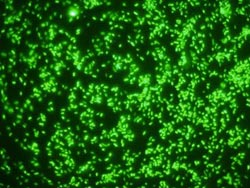How a versatile gut bacterium helps us get our daily dietary fiber

This image shows Bacteroides ovatus, wild strain.<br><br>Credit: Harry Brumer, UBC<br>
The findings illuminate the specialized roles played by key members of the vast microbial community living in the human gut, and could inform the development of tailored microbiota transplants to improve intestinal health after antibiotic use or illness. The research is published today in the journal Nature.
“While they are vital to our diet, the long chains of natural polymeric carbohydrates that make up dietary fibre are impossible for humans to digest without the aid of our resident bacteria,” says UBC professor Harry Brumer, with UBC's Michael Smith Laboratories and Department of Chemistry, and senior author of the study.
“This newly discovered sequence of genes enables Bacteroides ovatus to chop up xyloglucan, a major type of dietary fibre found in many vegetables – from lettuce leaves to tomato fruits. B. ovatus and its complex system of enzymes provide a crucial part of our digestive toolkit.”
About 92 per cent of the population harbours bacteria with a variant of the gene sequence, according to the researchers' survey of public genome data from 250 adult humans.
“The next question is whether other groups in the consortium of gut bacteria work in concert with, or in competition with, Bacteroides ovatus to target these, and other, complex carbohydrates,” says Brumer.
Background
The bacterial communities living in the human gut – roughly 100 trillion microorganisms – account for 50 per cent of the weight of the contents of the lower digestive tract in humans. Up to 10 per cent of our daily caloric intake can come from the breakdown of dietary fibre by our gut bacteria.
Researchers from the University of Michigan, the University of York, and the Swedish Royal Institute of Technology were also involved in the study.
Media Contact
More Information:
http://www.ubc.caAll latest news from the category: Life Sciences and Chemistry
Articles and reports from the Life Sciences and chemistry area deal with applied and basic research into modern biology, chemistry and human medicine.
Valuable information can be found on a range of life sciences fields including bacteriology, biochemistry, bionics, bioinformatics, biophysics, biotechnology, genetics, geobotany, human biology, marine biology, microbiology, molecular biology, cellular biology, zoology, bioinorganic chemistry, microchemistry and environmental chemistry.
Newest articles

High-energy-density aqueous battery based on halogen multi-electron transfer
Traditional non-aqueous lithium-ion batteries have a high energy density, but their safety is compromised due to the flammable organic electrolytes they utilize. Aqueous batteries use water as the solvent for…

First-ever combined heart pump and pig kidney transplant
…gives new hope to patient with terminal illness. Surgeons at NYU Langone Health performed the first-ever combined mechanical heart pump and gene-edited pig kidney transplant surgery in a 54-year-old woman…

Biophysics: Testing how well biomarkers work
LMU researchers have developed a method to determine how reliably target proteins can be labeled using super-resolution fluorescence microscopy. Modern microscopy techniques make it possible to examine the inner workings…





















